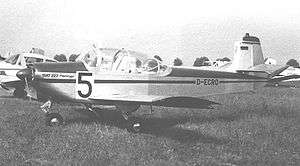MBB 223 Flamingo
The MBB 223 Flamingo was a light aircraft developed in West Germany in the 1960s in response to a competition for a standard trainer for the country's aeroclubs. Designed by SIAT, it was a conventional low-wing monoplane with fixed tricycle undercarriage. The cockpit was enclosed by a large bubble canopy. SIAT had not undertaken much production of the type before the firm was acquired by MBB in 1970. Eventually, the new owners transferred production to CASA in Spain.
| 223 Flamingo | |
|---|---|
 | |
| SIAT-built Flamingo at the Paris Air Show at Le Bourget Airport in June 1967 | |
| Role | Civil trainer aircraft |
| Manufacturer | SIAT/MBB CASA |
| First flight | 1 March 1967 |
A fully acrobatic, single-seat version, and a four-seat utility version were also developed.
Operational History
During the 2020 Turkish intervention in Idlib, Turkish airstrikes on Kweres Airfield destroyed at least 3 stored Syrian Air Force MBB 223 Flamingos. [1][2]
Variants

- Model 223A-1 Flamingo Trainer A1
- Two or four-seat trainer aircraft, powered by a 149-kW (200-hp) Avco Lycoming IO-360 piston engine.
- Model 223K-1 Flamingo Trainer K1
- Single-seat aerobatic aircraft, powered by a 149-kW (200-hp) Avco Lycoming AIO-360 piston engine.
- Model 223T-1 Flamingo Trainer T1
- One aircraft fitted with a turbocharged 157-kW (210-hp) Avco Lycoming TO-360-C1A6D piston engine.
- Model 223-M4
- The Model 223T-1 Flamingo Trainer T1 was later fitted with a Porsche PFM 3200 engine. One aircraft only.
Specifications
Data from Jane's All the World's Aircraft 1971–72[3]
General characteristics
- Crew: 2 (pilot and instructor)
- Capacity: provision for additional folding seat for two children or one adult
- Length: 7.43 m (24 ft 5 in)
- Wingspan: 8.28 m (27 ft 2 in)
- Height: 2.70 m (8 ft 10 in)
- Wing area: 11.50 m2 (123.8 sq ft)
- Airfoil: NACA 642A215
- Empty weight: 685 kg (1,510 lb)
- Max takeoff weight: 1,050 kg (2,315 lb)
- Fuel capacity: 220 L (58 US gal; 48 imp gal)
- Powerplant: 1 × Avco Lycoming IO-360-C1B air-cooled flat-four engine, 150 kW (200 hp)
- Propellers: 2-bladed Hartzell constant-speed, 1.80 m (5 ft 11 in) diameter
Performance
- Maximum speed: 243 km/h (151 mph, 131 kn)
- Cruise speed: 216 km/h (134 mph, 117 kn) (75% power)
- Never exceed speed: 380 km/h (240 mph, 210 kn)
- Range: 1,150 km (710 mi, 620 nmi)
- Service ceiling: 3,750 m (12,300 ft)
- Rate of climb: 4.30 m/s (846 ft/min)
References
| Wikimedia Commons has media related to MBB 223 Flamingo. |
- Taylor, John W. R., ed. (1971). Jane's All The World's Aircraft 1971-72. London: Jane's Yearbooks. ISBN 0-354-00094-2.CS1 maint: ref=harv (link)
- Taylor, Michael J. H. (1989). Jane's Encyclopedia of Aviation. London: Studio Editions. pp. 238, 638.